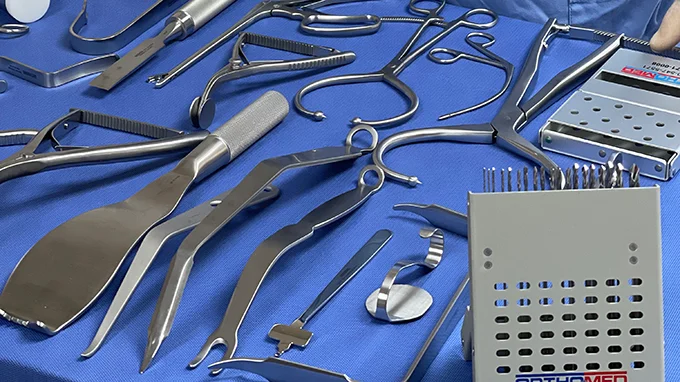Hand surgeries are very delicate procedures that require utmost care and precision; therefore, the surgical instruments must be top-notch. The primary role of an effective process hinges on its performance. Let’s carefully review this article, looking into the core hand surgery instrument set and how to apply them and highlighting why quality and specificity are all important with such delicate tools.
Why Sets of Hand Surgery Instruments Matter
In the case of every surgery, whether it is the surgery on the hands or another type of surgery, here, too, every millimeter matters. Whether about the treatment of fractures, the tearing of tendons, the repair of nerves, or reconstruction surgeries in hands, where complex arrangements include bones, tendons, ligaments, nerves, and blood vessels, different instruments are used. A properly acquired hand surgery instrument set assists the surgeon in successfully carrying out such procedures. Such may be complex but performed with the precision and efficacy necessary.
An integrated instrument set is a necessity
.Specifically, hand surgery instrument sets vary depending on the type of hand surgery performed, such as orthopedic, reconstructive, or microsurgery. Having a complete set, however, provides all possible needs in one organized tray so surgeons do not need to interrupt their work looking for something. The entire hand surgery instrument set has been prepared to cover the most common surgeries and intricate microsurgical reconstructions.
Major Parts of a Hand Surgery Instruments Set
Let us first identify the major parts that should be included in hand surgery instruments, as well as the use and functions of each type, and then group those into some essential categories to provide an overview. Some critical areas are cutting tools, grasping and holding tools, retractors, and other special tools necessary for hand surgeries.
Cutting and Dissecting Instruments
Cutting instruments are the most significant instruments of hand surgery used to cut, excise, or dissect tissues and delicate structures. There are basic cutting instruments in the hand surgery set. They include:
Scalpels and blades are the first instruments used in most surgical procedures, where they are allowed to create precise cuts of skin and soft tissues. Blades come in various sizes. Among the standard blade sizes, No. 10, No. 15, and No. 11 are those commonly used in hand surgery.
Scissors: Surgical scissors are of two types: Metzenbaum and Tenotomy scissors. These are designed to cut tissues cleanly., allowing the surgeon to avoid unnecessary tissue damage. This is very important in hand surgery, where many delicate structures are involved.
Bone Cutters: Bone cutters are used when bone needs to be removed or remodeled. They have been designed to cut bone cleanly and precisely, causing minimum damage to surrounding tissues.
2. Grasping and Holding InstrumentsIn hand surgery, tissues need to be managed, maneuvered, and readjusted to the best of their ability. Grasping instruments are offered, and a firm grasp for the finest tissue is required.
Forceps: The list of hand surgeries includes forceps of the types Adson, Brown, and DeBakey. They allow gentle and accurate manipulation of tissues, vessels, or nerves.
Needle Holders: Suturing in hand surgeries is one of those parts of the operation that often requires microsurgical accuracy. Needle holders, like Castroviejo needle holders, are specialized instruments for tiny, fragile needles.
3. Retractors
Retractors would stretch apart the surgical site to hold the tissue open, exposing and allowing easy view access for the surgeon.
Skin Hooks: Skin hooks are light and thin instruments commonly used in hand surgeries to retract the skin without damaging the tissue.
Hohmann Retractors: The Hohmann retractor is generally used in orthopedic hand procedures to retract bones and joints by gentle retraction of the tissues.
Senn Retractors: This is a highly convenient, dexterous retractor with a blunt and sharp end. On both sides, they offer excellent retraction for dissecting soft tissues or in deep dissections of a surgical procedure in hand surgery.
4. Micro and Fine Instruments
In all surgical hand procedures, miniaturized fine structures are involved in the more delicate cases, like those involving nerves and blood vessels. Fine instruments utilize precision in microsurgical terms, where forceps pinch but do not push forward.
Micro Needle Holders: These are fine needle holders like conventional ones, but smaller and more precise. They are used for delicate microsurgical suturing.
Micro Scissors: are miniature scissors used to cut the most minute tissues. They are essential in the hand surgery instrument set, which requires minute dexterity and precision.
5. Bone and Joint Instruments
For the specific hand surgeries that involve intervention on bones and joints – such as fracture repair or joint stabilization – the instruments required are those that work with the bone.
Osteotomes are chisel-like instruments used to cut or shape bones. Osteotomes come in various sizes and are inevitable for major and minor bone procedures.
Rongeurs: bone rongeurs remove small portions of bone or cartilage. They are indispensable to surgeries that cut or shape bone and cartilage.
see more details about Castro surgical instrument
6. Soft Tissue and Nerve Instruments
Procedures performed on the hand and around nerves, tendons, and soft tissues require precise machinery to cause minor damage to these tissues.
Tendon passers are usually used to pass or guide enduring hand-hand procedures such as tendon transfer operations.
Nerve HoThese oks are manufactured strictly for use with sensitive nerves. They are necessary for repairing and reconstructing nerves.
Factors Determining Selection from Hand Surgery Instruments Set
A few factors determine a qualified and high-quality experience as far as surgery is concerned whenever a hand surgery instrument set is opted for:
Quality and Durability: Hand surgery instruments must undergo repeated sterilizations, so they should be relatively strong.
Instruments compatibility: A pre-curated hand surgery set should enable different types of hand surgery. FSurgeons can perform various surgeries without changing the instrumentation.
Sterilization Compatibility: The instruments must be easy to sterilize to keep the working area clean. Liveable or compatible instruments with other forms of sterilization are also crucial in a hospital.
Improvements in Hand Surgery Instruments
Technology has made hand surgery instruments more refined and specified. Modern technology has invented laser precision for manufacturing instruments, thus reducing the instrument’s weight and improving the surgeon’s manipulation ability to produce even better results through increased efficiency.
Robotics and minimally invasive tools are also on the rise in the field, though they are less prevalent in hand surgery.
Conclusion
A good set of hand surgery instruments is the hallmark of effective and safe hand surgeries. From cutting and dissecting to specialty microsurgical instruments, every tool has a role in ensuring that a successful procedure can be completed. For anyone working in surgical supply or healthcare, knowing the many components and considerations involved in assembling an optimal hand surgery instrument set can benefit surgical outcomes and patient satisfaction.
 The Random Collective Where Curiosity Meets Creativity
The Random Collective Where Curiosity Meets Creativity






